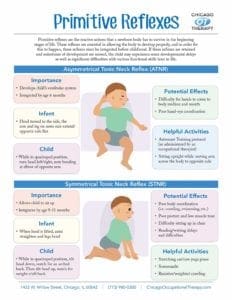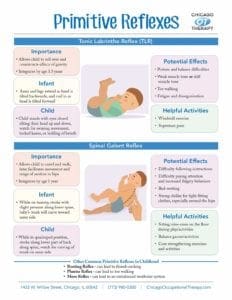Primitive reflexes are the reactive actions that a newborn baby uses to survive in the beginning stages of life. These reflexes are essential in allowing the body to develop properly, and in order for this to happen, these reflexes must be integrated before childhood. If these reflexes are retained and milestones of development are missed, the child may experience some developmental delays as well as significant difficulties with various functional skills later in life.
Why is this reflex important?
- Develops the child’s vestibular system
- Integrated by age 6 months
Potential effects if retained:
- Difficulty for hands to come to the middle of the body and to the mouth
- Poor hand-eye coordination
Helpful activities for integration:
- Ant’s Marching activity
- Hold both arms out in front of the body with shoulder and elbows straight and palms down arms should be parallel to your shoulders
- March in place while maintaining this position
- Instruct child to look to the left or right side while maintaining arms straight out in front of body
- You can downgrade this activity to decrease the complexity of the task – have your child stand still to eliminate having to coordinate an upper and lower body component
- Sitting on the floor or table, moving the arm across the body to the opposite side to pick up items
Symmetrical Tonic Neck Reflex (STNR)
Why is this reflex important?
- Allows child to sit up
- Integrates by age 9-11 months
Potential effects if retained:
- Poor body coordination of the left and ride side of the body (for example – difficulty with crawling, swimming, etc.)
- Decreased strength and activity endurance
- Difficulty sitting with a tall, upright position in a chair
- Reading/writing delays and difficulties
Helpful activities for integration:
- Stretching cat/cow yoga poses
- Download Chicago Occupational Therapy’s book, The Ultimate Mini Guide to Pediatric Exercises for more information about how to do these yoga poses!
- Somersaults
Tonic Labrinthine Reflex (TLR)
Why is this reflex important?
- Allows the child to roll over and counteracts effects of gravity
- Integrates by age 3.5 years
Potential effects if retained:
- Posture and balance difficulties
- Decreased strength
- Toe walking
- Fatigue and decreased activity endurance
Helpful activities for integration:
- Windmill exercise
- Superman pose
- Download Chicago Occupational Therapy’s book, The Ultimate Mini Guide to Pediatric Exercises for more information about how to do these poses!
Why is this reflex important?
- Allows the child to crawl and walk, later facilitates movement and range of motion in hips
- Integrates by age 1 year
Potential effects if retained:
- Difficulty following instructions
- Difficulty with paying attention/increased fidgety behaviors
- Bed-wetting
- Strong dislike for tight fitting clothes, especially around the hip region
Helpful activities for integration:
- Sitting criss-cross on the floor during play/activities
- Balance games/activities
- Core strengthening exercises/activities
- Download Chicago Occupational Therapy’s book, The Ultimate Mini Guide to Pediatric Exercises for more information about core strengthening activities
Other Primitive Reflexes
While this list is not exhaustive, some other commonly retained reflexes in childhood include:
- Rooting reflex– can lead to thumb sucking
- Plantar reflex– can lead to toe walking
- Moro reflex– can lead to an imbalanced vestibular system
For additional information please download Chicago Occupational Therapy’s infographic, “Primitive Reflexes.” If you have questions or concerns about your child’s functioning and/or possible retained reflexes, please Contact Chicago Occupational Therapy or call (773) 980-0300 to learn more about our services and how we can help your child flourish and grow.


